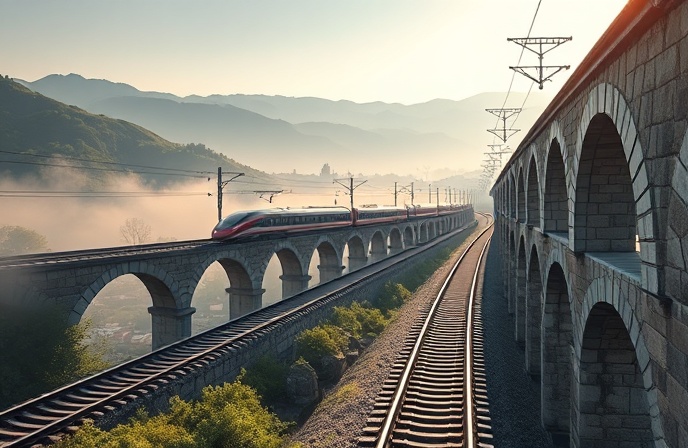Sicily’s High-Speed Rail Upgrade: Webuild’s €640M Project

This article examines the significant railway infrastructure development project underway in Sicily, Italy, focusing on the Palermo-Messina-Catania high-capacity railway line upgrade. The project, spearheaded by Webuild in consortium with Pizzarotti, represents a substantial investment in improving regional connectivity and travel times within the Trans-European Transport Network (TEN-T). We will analyze the scope of the project, its technological implications, the financial aspects, and its broader significance within the context of Italy’s national infrastructure development plan and the European Union’s sustainable mobility initiatives. This analysis will delve into the challenges and opportunities presented by this large-scale undertaking, offering insights into the intricacies of modern railway construction and its impact on regional economies and transportation systems.
The Webuild Contract and its Scope
Webuild, a leading Italian construction company, has secured a €640 million contract from Rete Ferroviaria Italiana (RFI) (Italian Railway Network) (Gruppo FS Italiane) for the design and construction of Functional Lot one of the Fiumefreddo-Taormina/Letojanni section of the Giampilieri-Fiumefreddo railway line. This forms a crucial part of the larger Palermo-Catania-Messina high-capacity railway upgrade. The project encompasses approximately 15 km of new track, including the construction of a new underground station in Taormina, two significant viaducts (Fogliarino and Alcantara), an artificial tunnel at Fiumefreddo, and three natural tunnels (Calatabiano, Letojanni, and Taormina). The project also involves the interconnection at Taormina/Letojanni and the decommissioning of existing infrastructure along the current Fiumefreddo section. This intricate work requires precise engineering and logistical planning to minimize disruption to existing services.
Technological Advancements and Modern Railway Practices
The project isn’t merely about laying new tracks; it embodies advancements in railway engineering and technology. The design incorporates modern signaling systems and infrastructure improvements aimed at increasing operational efficiency and safety. The planned increase in train speeds to 200 km/h on the Bicocca-Catenanuova section necessitates the implementation of advanced track design and signaling technologies to ensure safe and reliable high-speed operations. The integration of Intelligent Transportation Systems (ITS) is likely to play a critical role in optimizing train scheduling, traffic management, and overall network performance. The use of modern construction techniques and materials will further contribute to the project’s success and long-term sustainability.
Financial and Economic Implications
The €640 million contract represents a significant investment in Sicily’s infrastructure. This project, along with other railway upgrades funded by the Piano Nazionale di Ripresa e Resilienza (PNRR) (National Recovery and Resilience Plan), signifies Italy’s commitment to modernizing its transportation network. The economic benefits extend beyond the construction phase, encompassing job creation, increased regional connectivity, and potential economic growth spurred by improved accessibility. The faster travel times between Messina and Catania, reduced to approximately 30 minutes, will have a profound impact on commuters and businesses, boosting productivity and facilitating economic activity.
European Context and Sustainable Mobility
This project sits within the broader context of the Trans-European Transport Network (TEN-T), specifically the Scandinavia-Mediterranean corridor. It aligns with the European Union’s commitment to sustainable mobility and aims to enhance the efficiency and environmental performance of the railway network. By investing in high-speed rail, Italy contributes to the overall goal of reducing reliance on road transportation, mitigating greenhouse gas emissions, and promoting sustainable transport solutions across the continent. The integration of this Sicilian upgrade into the wider TEN-T network will strengthen the connectivity of the region to other European countries and foster cross-border trade and collaboration.
Conclusions
The Webuild-led project to upgrade the Palermo-Messina-Catania railway line is a transformative undertaking with far-reaching implications for Sicily and Italy as a whole. The project’s substantial financial investment, the integration of modern technologies, and its alignment with the EU’s sustainable mobility objectives highlight its importance within the context of national and European infrastructure development. The enhanced connectivity resulting from improved travel times and increased capacity will undoubtedly stimulate economic growth and improve the quality of life for residents of the region. The success of this project, along with other initiatives under the PNRR, will be instrumental in enhancing Italy’s transport infrastructure and demonstrating the country’s commitment to modern, efficient, and sustainable transportation solutions. The project showcases the complex interplay of engineering, finance, and policy in creating modern, efficient railway systems. The challenges associated with large-scale infrastructure projects, including logistical complexities, environmental considerations, and managing stakeholder expectations, are all addressed within this ambitious undertaking. The successful completion of this project will not only benefit the local communities in Sicily but will also serve as a model for future railway development projects across Europe, contributing to the continent’s continued progress towards a more sustainable and interconnected transportation network. Furthermore, the project highlights the crucial role of private sector participation in public infrastructure development, demonstrating a successful partnership between Webuild, Pizzarotti, and RFI in delivering a crucial element of Italy’s modernization strategy.





